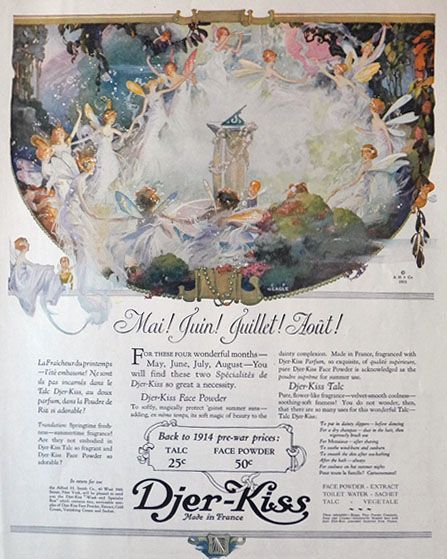Art of Djer-Kiss: Pleasure, frivolity, and aesthetics
by Ty Hulse
The 1920s was still haunted by the ghost of “The Great War” which had ushered in modern mechanized warfare with the birth of tanks, chemical attacks, bomb carrying planes, and the disease filled trenches that nearly killed Tolkien. This time, after the war, came to be known as the Roaring 20s, and a frivolous generation. In truth, however, the people of that era were in fact running, trying to escape the horror and, in many cases, the shell shocked post-traumatic stress of a war that had left many of the old values dead beside those they loved.
In 1917, near the end of the war which must have seemed to go on forever a pair of girls photographed what they claimed were fairies. Their photographs caused an emotional and psychological stir in society that lingers to this day.
It was a period when the majority of the population had lost a close relative in the first world war, and understandably there was a consequent surge of interest in manifestations of other worlds and the after life such as spiritualism, theosophy and the fairies. Edward Gardner, who discovered the fairy photographs, was a theosophist, and Conan Doyle, who had lost his son in the war, was a committed spiritualist. It is perhaps this sense of desolation following the losses of the war, and the desperate search for signs of an afterlife (Postmodern Fairies by Helen Nicholson)
It is into this world the Djer-Kiss released a series of ads featuring whimsical and beautiful paintings of fairies, one of which promised a return to “pre-war prices” below a celebration of white, dancing beauties. The fairies, like many such paintings are surrounded by a circle of dark wilderness, yet within their circle is a purity and brightness. Yet it isn’t a full circle, there is a gap opening up in it, not one that faces directly towards us, but one that is moving towards us, where the fairies have parted in preparation to invite us, the viewers, in.
Featuring fairies in this way wasn’t an accident, fairies had often been a symbol of hope. In a early 19th Century German memorate a young woman, struggling with her hard Industrial Era job asks her friend; “Wouldn’t you like to marry one of the fairies?” as they hear the sounds of the zwerg reveling in the hill beneath their feet. For many, fairyland must have seemed a type of heaven, which is likely why graves in Ancient Greece sometimes read that the children’s spirit would now be able to play forever with the nymphs.
We see this sort of desperate hope for purity, for a sort of heaven and peace in these paintings. They beg us not to return to the war that was, to move forward towards a better world.
Another ad features fairies swinging joyfully on vines. In some ways this is reminiscent of the paintings of the Rococo period. Like the 1920s the aristocracy of the early 1700s would ponder what happiness is and like the 20s they seem to have ultimately come to the conclusion that what makes someone happy is what feels good. That what is good is to enjoy life. Have romantic trysts in which you playfully let one man look up your skirt, while being pushed on a swing by another. Dress frilly and bright. Travel, eat, drink, and enjoy beautiful things.
Because of the decadent and sexualized nature of the Rococo it is often depicted with a naughty, sexual twist. Much as the fairies had often been thought of. There was, after all, a history of men and women dreaming of beautiful fairy lovers. Further, fairy decadence and celebration, like the Rococo had often been depicted with a mischievous edge to it, such as in “A Midsummer Night’s Dream.”
















0 comments:
Post a Comment